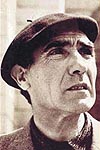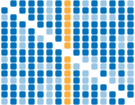The page of Alves Redol, António , English biography
Biography
António Alves Redol (29 December 1911 - 29 November 1969) was one of the most influential Portuguese neorealist writers. Redol was born in Vila Franca de Xira, an industrial zone near Lisbon. In 1927 he finished school and in the next year travelled to the Portuguese colony of Angola, where he stays for three years. His experience in Angola was a bit unsuccessful, but gave him another view of the world, thing that would later be present in his literature.His literary activity started in 1936, when Redol became a contributor of O Diabo, a Portuguese newspaper, writing chronicles and tales of his region, Ribatejo. But Redol would become known, not for his work as a journalist, but for his romances. In 1939 he published his first book, Gaibéus, in the author's opinion, Gaibéus was not intended to be a piece of art, but a report of the living conditions of the peasants of Ribatejo.
This preoccupation of not being only a writer but also a reporter of the real world is a main characteristic of Redol's work. Redol used to get near the fields in order to talk to the peasants of the rice fields near Tagus river, hearing their stories and experiences.
His work continued, and Redol also published Marés, in 1941, Avieiros, in 1943, Fanga, in 1944, Reinegros, in 1945, Porto Manso, in 1946, Ciclo Port-Wine in 1953, a Barca dos Sete Lemes in 1958, Uma Fenda na Muralha, in 1959 and finally, Barranco de Cegos, in 1962, considered by most his masterpiece.
A Man with Seven Names was translated into the English language in 1965 by Linton Lomas Barrett.
Alves Redol died in Lisbon, in 1969.
source :: wikipedia




